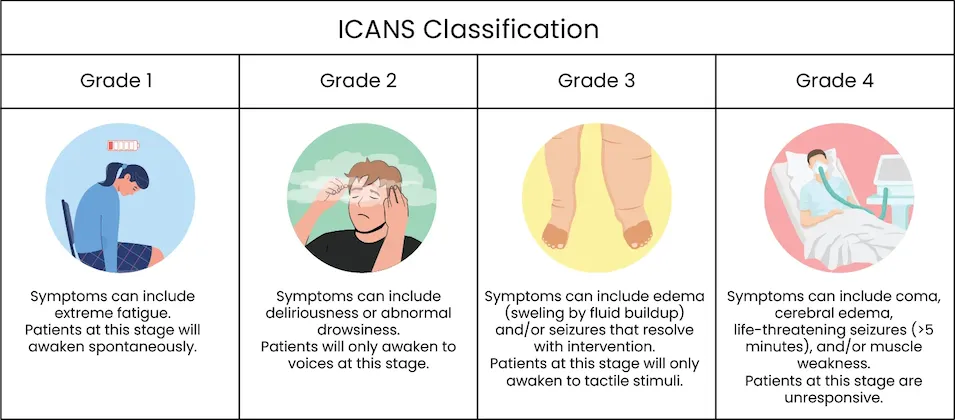Neurotoxicity and ICANS
Neurotoxicity is a side effect of CAR T-cell therapy liso-cel. Neurotoxicity is a general term used to describe any side effect that affects the nervous system. In the context of cancer treatment, it can include direct damage to nerve cells, disruption of the communication between brain cells, or an immune reaction against the nervous system.
What is ICANS?
ICANS (immune effector cell-associated neurotoxicity syndrome) is a type of neurotoxicity that occurs when activated immune cells cross the blood/brain barrier and leak into the brain, causing inflammation and damage to the brain tissue. It is a common and potentially serious side effect of CAR T-cell therapy.
ICANS typically occurs early during the treatment process. Early detection and intervention are crucial for managing ICANS and minimizing its impact on quality of life. As a patient, family member, or caregiver, it's important to be aware of ICANS symptoms and be prepared to report any irregularities to your healthcare team.
ICANS symptoms tend to appear slightly later than cytokine release syndrome (CRS) and last longer than CRS side effects. ICANS symptoms can often be managed with supportive therapies and resolve over time.
What are the Symptoms of ICANS?
The symptoms of ICANS can vary depending on their grade of severity. Mild symptoms include confusion, headaches, fatigue, and trouble communicating. Severe and potentially life-threatening side effects can include seizures, raised intracranial pressure with cerebral edema (swelling of the brain), and coma.
How are ICANS Symptoms Classified and Treated?
ICANS symptoms can be measured on a grading level from 1-4 to determine their severity.

Grade 1
Patients should be closely monitored and receive supportive measures if needed. Symptoms in Grade 1 includes extreme fatigue and confusion. Patients at this stage will awaken spontaneously.
Management in this stage includes:
- Supportive care
- IV hydration
- Neurology consultation (questions asked to assess awareness/consistency)
- Imaging tests like EEG (electroencephalogram/brain scan) or MRI (magnetic resonance imaging)
- Consider antiepileptic (anti-seizure) drug
Grade 2
Symptoms in Grade 2 include deliriousness or abnormal drowsiness. Patients will only awaken to voices at this stage.
Management reactions in this stage include:
- Supportive care included in Grade 1 ICANS management
- Consider an ICU transfer
- Consider an antiepileptic (anti-seizure) drug, if not already started
- Low-dose corticosteroids
Grade 3
Symptoms in Grade 3 include edema (sweling by fluid buildup) and/or seizures that resolve with intervention. Patients at this stage will only awaken to tactile stimuli.
Management reactions in this stage include:
- Supportive care included in Grade 2 ICANS management
- An ICU transfer
- Continuous corticosteroids
- Continuous antiepileptic (anti-seizure) drugs
- Imaging tests for monitoring
Grade 4
Symptoms in Grade 4 include coma, cerebral edema, life-threatening seizures (>5 minutes), and/or muscle weakness. Patients at this stage are unresponsive.
Management reactions in this stage include:
- Supportive care included in Grade 3 ICANS management
- High-dose corticosteroids
- Specific neurointensive treatment (status epilepticus, brain edema)
- Consider further individual treatment